
by Beth Bolles | Aug 9, 2025
You have probably heard about the SoilKit testing option that is available at local UF IFAS Extension offices. Why would you want to use a new testing kit when the traditional soil testing kit is still available ?
UF IFAS Extension SoilKit is an option for those who want their turfgrass test results based on the latest evidence-based science. This is especially important when dealing with the application of phosphorus, a potentially polluting nutrient. If your soil measures adequate phosphorus for our warm season turfgrasses, you don’t want to add more.
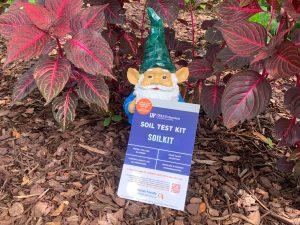
UF IFAS Extension SoilKit. Photo by Beth Bolles, UF IFAS Extension Escambia County.
The good news is that UF IFAS turfgrass research has established thresholds for when nutrients like phosphorus are needed. SoilKit is aligned with these thresholds and will only recommend nutrients based on the evidence-based science.
SoilKit does cost more than the traditional soil testing. The convenience is that it includes postage so you put it directly in your mailbox for pickup. Another positive is that when you register your kit online, you can locate your home on a map and mark the square footage of the lawn area. When you get your results in a few days, there is no guess work. You will get a list of products and amounts to purchase for your size lawn.
SoilKit can be used to test other plant groups including gardens and shrubs. If you have questions about using SoilKit, your local Extension office can help.

by Beth Bolles | Jun 20, 2024
The May Gardening in the Panhandle Live focused on the various aspects of turfgrass care and species characteristics.
The panel included:
Dr. Bryan Unruh, UF IFAS Extension Turfgrass Science Professor
Sheila Dunning, UF IFAS Extension Commercial Horticulture Agent in Okaloosa County
Josh Criss, UF IFAS Extension Residential Horticulture Agent in Santa Rosa County
Daniel Leonard, UF IFAS Extension Horticulture Agent and Director in Calhoun County
Q: Does No Mow March cause more problems in maintaining a good lawn?
Pay attention to what you are leaving behind. If you have aggressive perennial weeds, that could cause issues later. Also, be aware of what types of weeds. Annual wildflowers may be acceptable that will reseed next year. Mowing before seeds mature is always an option too.
Remember that if there are significant weeds, they are taking advantage of a void in the turf. Find out why the turf is not growing as well and work on that issue. Improve the health of the grass to have less issues with some weeds.
References: https://apnews.com/article/gardening-no-mow-may-lawns-6aa1669b9e9bb5b5d8ea671c44d186f2
Q: What is an unhealthy lawn?
Grass that is not performing at a level that is normal for that turf. Not growing well, does not have appropriate color for the species, thinning out. The difficult part is figuring out why. Could be that that turf is not suited to the site, cultural practices are an issue, pest problem.
We tend to manage turf too much. Take a more minimalistic approach and as needed for turf management instead of a scheduled maintenance plan.
Q: Fertilizer and pesticide inputs aside, can ornamental lawns provide environmental benefits such as carbon sequestration?
Plants remove CO2 and supply O2. Turf areas can reduce temperatures, serve as erosion management and build soil. Also filtering some pollutants. Turfgrass also has huge potential to accumulate and store carbon. Turf has many recreational uses that other surfaces don’t offer and the overall aesthetics of a healthy lawn can improve value of the property.
References: Turf Management to Protect the Environment, https://www.youtube.com/watch?v=w2ajI-t4EoY
Q: What is the best grass for Florida?
You have to match the turf to an appropriate site and turfgrass may not be the best choice for a site. On an urban site, shade from trees will also dictate if turf is appropriate. The best grass for the back yard may not be the best suited for the front yard.
Centipedegrass is a good selection for the case of a grass that grows well with low inputs. It will be a lighter shade of green which is its natural color.
If you prefer to have inputs of fertilizer and water routinely, centipedegrass would not be the best choice. Zoysiagrass is more suited for those who desire a more magazine cover type lawn that is well manicured.
A field type lawn is best with bahiagrass.
Q: Is zoysiagrass the fastest growing market for turfgrass?
There are now good zoysiagrass varieties on the market and better ones coming along.
Zoysiagrass is a very drought tolerant species but it survives by going into dormancy. It survives without water by going from green to bluishgray to brown very quickly. In order to maintain a green, well manicured zoysiagrass lawn, irrigation input is needed.
Q: Can I grow a lawn from centipedegrass seed? How long will it take to fill in?
It takes 3 years to establish a lawn from centipedgrass seeding. That is with minimal inputs but mowing is important in the establishment process.
Dr. Unruh does not recommend seeding into patches because water needs for seed are higher than established grass. Sodding or plugging is better for patching spots.
Q: What is the best choice of grass for a partly shaded lawn/best under a large tree?
Long term, you need a shade tolerant grass such as one of the St. Augustinegrasses or certain cultivars of zoysia (Palisades is one). As the tree grows over the years, grass may not remain suited for that location.
Q: What type of grass would you recommend for a meadow area that would be natural/unmowed?
Bahiagrass is a good option.
Q: How do we encourage bee lawns?
Centipedegrass flowers will attract some bees. Clovers (Red, white, hopclover) in the winter months through spring. Consider your space. May just be small sections or at the edge of the yard.
Q: How often should you aerate your lawn and what is the best method?
Sandy soils can compact. Every other year aeration if you have traffic patterns from vehicles, play, or paths. Use a ½ tine with lots of holes back and forth over the lawn.
Q: How to maintain a healthy lawn in our hot and humid summers?
Overwatering is common. Grass gives signs of needing water such as leaf blades folding in half, a color change, and grass not recovering after walking. Calibrate your system to apply ½ to ¾ inch at each time.
References: Mowing Your Florida Lawn, https://edis.ifas.ufl.edu/publication/LH028
Q: How to measure water volume with an automatic irrigation system.
In a zone, randomly place 10-15 straight edged cans that are all the same size. Run your system for a set time and see how much is in each can. You will be able to see where coverage is poor, just right, and overlapping too much. Measure with a ruler and average out the amount. Adjust your time to meet ½ to ¾ inch.
Each zone is calibrated separately.
Same for zoysiagrass but this grass will show you where your system is not functioning well since it’s response to drought is to go dormant. Still ½ to ¾ inch as needed.
References: Watering Your Florida Lawn, https://edis.ifas.ufl.edu/publication/LH025
Calibrating Your Sprinkler System, https://gardeningsolutions.ifas.ufl.edu/care/irrigation/calibrating-your-irrigation-system/
Q: Do I have to fertilize and apply pesticides to have a healthy lawn?
No. All plants need nutrition and fertilizer is just one source of nutrition. A good soil can provide sufficient levels of nutrients for the lawn. Sandy soils may need supplemental nutrients. Could be from compost incorporated in as well.
References: The Florida Fertilizer Label, https://edis.ifas.ufl.edu/publication/SS170
Q: My yard is a mix of grasses. Is this a problem for fertilizer and watering?
You may need to fertilize differently depending on the needs of the various grasses. If a grass is growing into another, then it is favorable conditions for that grass – sunlight, mowing, water availability. You may have to manage for the one that is doing the best.
Q: Should I bag my mowing clippings for my Zoysia lawn or not?
Generally the recommendation is to allow clipping to fall for a yard that is being routinely mowed. Blades will compost. The exception is with zoysia when thatch is becoming a problem or when you have neglected mowing for a period and clumps of clipping are piled on the lawn.
References: Zoysiagrass for Lawns, https://edis.ifas.ufl.edu/publication/LH011
Q: Is weed control beneficial or harmful?
Improperly used herbicides could have environmental impacts. Follow the label carefully. Manage weeds through cultural practices too.
Q: How do I get rid of crabgrass?
Annual weed that germinates when soil temps reach 55 degrees F. Could be mid-January or a little later. Pre-emergent herbicides can help. Not many options for post emergent weed control.
From Dr. Unruh: We do not recommend Weed and Feed products since timing is different for both. North Florida fertilizer applications should not occur before mid-April.
0-0-7 with pre-emergent would be the only exception. The 0-0-7 is just potassium.
Q: How to detect, kill and prevent ground pearls.
There are no chemicals controls for ground pearls. Thinning out areas. Insects that are in the soil, with pearl stage attached to the roots. Females are hot pink and crawlers.
Maybe something in the future. Try to outgrow ground pearls with faster growing grasses such as St. Augustinegrass and zoysiagrass.
Q: How do you control a heavy infestation of doveweed?
Do not handpull. Annual weed that germinates later when soils reach 70 degrees F. Pre-emergent herbicides. Mow more often and manage irrigation. Improve drainage. Clean mowers too.
Q: Are there herbicides that will not harm birds?
Insecticides have the biggest impact on wildlife compared to other types of pesticides. Many herbicides use a carrier that looks like a grain so water immediately according to label to move chemical off carrier. Follow the restrictions about application close to water. Read the label.
Q: Are all zoysia grasses hard to keep out of landscape beds?
Establish a border with edging to block the growth. Must be buried and above grade as well.
Q: If we’ve lost most of our backyard due to killing off weeds with only some grass left, how’s the best way to start?
For smaller spots, allow surrounding turf to run back into areas. Resodding areas or plugging new grass.
Q: Large sections of my front lawn died last summer and I diagnosed it as brown spot/large patch. How do I address?
Why having large patch – poor drainage and fix that issue. Also zoysiagrass is susceptible to large patch. You can restablish grass but manage so conditions are not as suitable for the disease. Water as needed and nutrients only as needed.
Q: We have a lot of bald spots in our yard that we can’t seem to get rid of.
Diagnosing is necessary – compaction, water issues, fertility problems. Loosen area and make sure water is able to move into soil. Then can reestablish grass.
Q: If your centipede lawn is spotty with a variety of weeds, would it be better to kill the whole thing off and sod with Zoysia?
Centidegrass and zoysia have different pH requirements so may not be as simple as just replacing with new type of grass. Why is centipedegrass not doing well? Soil testing and cultural practice evaluation before considering to replace grass. Current centipedegrass may just need different care to thrive.
Q: What is the best alternative to turf grass?
Perennial peanut is an option as a vegetative cover. It does freeze back in many spots of North Florida. It does creep and there are many cultivars. Edging is necessary.
Sunshine mimosa is an option but it also freezes back. Lyre leaved sage for shady areas.
Silkgrass for drier areas.
Frogfruit for moist areas
Final thoughts from Dr. Unruh
Shut the irrigation off. Most people tend to overwater. Back off inputs to as needed instead of a schedule. A few weeds are ok for most home lawns and lawns can still be attractive.
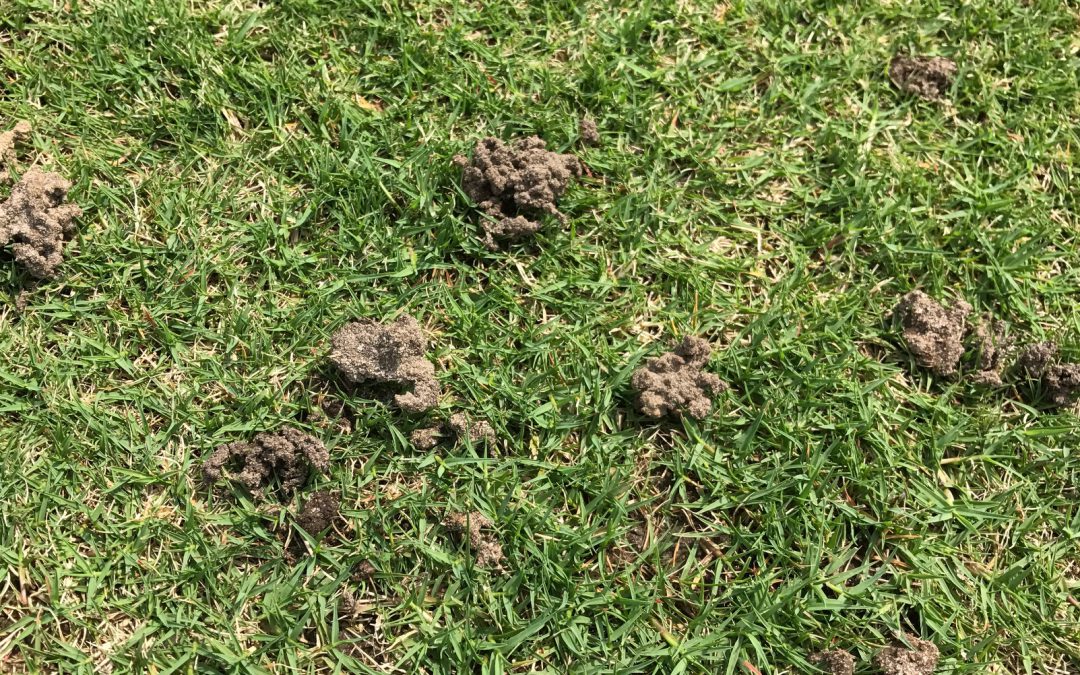
by Mary Salinas | Apr 15, 2021
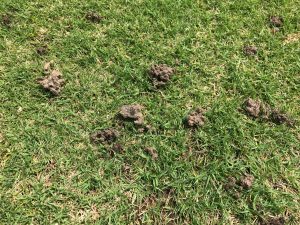
Worm mounds in bermudagrass. Photo credit Mary Salinas, UF IFAS Extension.
The April 8 program of Gardening in the Panhandle LIVE! was focused on turfgrass, quite a popular topic in the springtime as the weather warms and turf comes out of winter dormancy. Here are some of the questions asked of our University of Florida experts and the links to resources they shared.
To start with, two sites that have comprehensive information are Your Florida Lawn: http://hort.ufl.edu/yourfloridalawn/ and Gardening Solutions: https://gardeningsolutions.ifas.ufl.edu/
Turfgrass Selection
Q. What’s the answer to “I want a lawn like I had up north”? Remotely possible?
A. You can have a nice lawn, but it is going to be different in the panhandle. Don’t expect the same grass species or maintenance.
Q. What grass species is recommended for winter overseeding, and when should the grass be sown?
A. Overseeding has its problems and generally not recommended as it shades out the warm season turf as it is coming out of dormancy in the spring. Overseeding Florida Lawns for Winter Color: https://sfyl.ifas.ufl.edu/archive/hot_topics/lawn_and_garden/overseeding_winter_lawns.shtml
Q. How well do new turfgrass varieties thrive against weeds?
A. A healthy and properly maintained lawn is your best defense against weeds and other pests. Additionally, ProVista is a new cultivar of St Augustinegrass that can tolerate glyphosate so it makes it much easier to kill weeds in the lawn. ProVista is not yet widely available in the panhandle.
Q. How do I get a lawn started?
A. Preparing to Plant a Florida Lawn: https://edis.ifas.ufl.edu/lh012
Establishing a Florida Lawn: https://edis.ifas.ufl.edu/topic_lawn_establishment
Q. Can I have a native lawn? What are some recommended alternatives to a turf lawn?
A. Opinions are divided as to whether St. Augustinegrass is native. See these links for lawn Alternatives: https://gardeningsolutions.ifas.ufl.edu/lawns/turf-types/alternatives-to-turfgrass.html
https://gardeningsolutions.ifas.ufl.edu/mastergardener/webinars/mg-update-june2018/ffl-lawn-alternative-mg-update-june-2018-handout.pdf
Fertilizing & Weed Control
Q. How long should I wait before fertilizing new sod?
A. Wait 30-60 days before applying fertilizer. See: Homeowner Best Management Practices for the Home Lawn: https://edis.ifas.ufl.edu/ep236
Q. Basic fertilizer for most lawns if no other information is available.
A. 15-0-15
Q. Are weed and feed products effective? Can you use a Weed & Feed like Scott’s Bonus S this late in the year?
A. Weed and feed products are not recommended.
Weed & Feed, Not Foolproof: https://ocmga.wordpress.com/2013/03/11/weed-and-feed-not-foolproof-by-larry-williams-ufifas-extension-agent/
Weed Management Guide for Florida Lawns: https://edis.ifas.ufl.edu/ep141
Lawn Maintenance & Renovation
Q. My husband overwaters the lawn. Remind everyone about correct watering.
A. Homeowner Best Management Practices for the Home Lawn: https://edis.ifas.ufl.edu/ep236
Watering Your Florida Lawn: https://edis.ifas.ufl.edu/lh025
Sprinkler calibration: https://gardeningsolutions.ifas.ufl.edu/care/irrigation/calibrating-your-irrigation-system.html
Q. What to do about bare spots in St Augustine turf in shade?
A. Rough up the ground and put ½ to 1” compost and let the grass fill in or plant plugs. St. Augustinegrass for Florida Lawns: https://edis.ifas.ufl.edu/lh010
Q. When is the best time to overseed? I have a centipede lawn that’s 15-16 years old and I’m trying to bring it back to health.
A. Be sure to be following good practices and centipedegrass should not fail. Overseeding may not be the best option. Centipedegrass for Florida Lawns: https://edis.ifas.ufl.edu/lh009
Q. How do I repair lawn areas ruined by piled up Hurricane Sally debris?
A. Homeowner Best Management Practices for the Home Lawn: https://edis.ifas.ufl.edu/ep236
Q. How do I care for a zoysiagrass lawn?
A. Zoysiagrass for Florida Lawns: https://edis.ifas.ufl.edu/lh011
Q. Should I mulch or bag clippings?
A. Unless you have disease or weed seeds, mulch the clippings onto the turf so you can return the nutrients and water into the soil. Mowing Your Florida Lawn: https://gardeningsolutions.ifas.ufl.edu/lawns/lawn-care/mowing-your-florida-lawn.html
Pest Management
Q. When is the best time to put out a pre-emergence treatment to control and prevent weeds in your lawn (warm and cool season)?
A. Summer Annual Weed Control Timeline: https://sfyl.ifas.ufl.edu/media/sfylifasufledu/escambia/horticulture/Summer-Annual-Lawn-Weed-Control-Timeline.pdf
Winter Annual Weed Control Timeline: https://sfyl.ifas.ufl.edu/media/sfylifasufledu/escambia/horticulture/Winter-Annual-Lawn-Weed-Control-Timeline.pdf
Q. How do I manage chamberbitter in lawns?
A. Chamberbitter: https://hgic.clemson.edu/factsheet/chamberbitter/
Gallery, with the active ingredient isoxoben, has always been the best product to control chamberbitter. Another product, Gemini, adds prodiamine with isoxoben and also provides good control.
Q. How do you get dollar weed under control?
A. Control irrigation. Dollarweed loves lots of water so make sure you are not overwatering. See: https://edis.ifas.ufl.edu/ep389
Q. I used Image to help control Bahia in Centipede. Anything else that we can use?
A. Metsulfuron methyl, 3 applications every 21 days
Q. Which postemergence herbicide is safe and effective for reducing oxalis in a lawn?
A. Yellow Woodsorrel (Oxalis) Biology and Management in Turf: https://edis.ifas.ufl.edu/ep385
Q. What is the best non-poison weed killer?
A. If a product is a weed killer, whether it is organic or synthetic, it is a poison. Alternatives to Synthetic Herbicides for Container Plants & Homeowner Herbicide Guide: https://edis.ifas.ufl.edu/ep464 & https://edis.ifas.ufl.edu/ep575
Q. How do I treat lawn fungus?
A. First you need to determine which fungus, if any, is responsible. Key to Identification of Landscape Turfgrass Disease: https://edis.ifas.ufl.edu/lh064
Then turn your attention to Turfgrass Disease Management: https://edis.ifas.ufl.edu/lh040
Q. How do I diagnose and control mole crickets?
A. Look at this UF guide: https://edis.ifas.ufl.edu/in1021
This video shows how to do the soap flush to scout for mole crickets https://www.youtube.com/watch?v=sx_o4EMXsCo

by Matt Lollar | Aug 1, 2019
Large patch Rhizoctonia solani (known as brown patch in cool season grasses) is a common disease of many turfgrass species. It usually occurs during the cooler months from October through May when temperatures are below 80 degrees Fahrenheit. However, signs and symptoms of large patch and other Rhizoctonia diseases can be observed throughout the summer. Less common Rhizoctonia species that occur during the summer months are Rhizoctoni zeae and Rhizoctonia oryzae. Extended periods of turf wetness from excessive rainfall or overwatering provide ideal conditions for the disease to develop and spread.
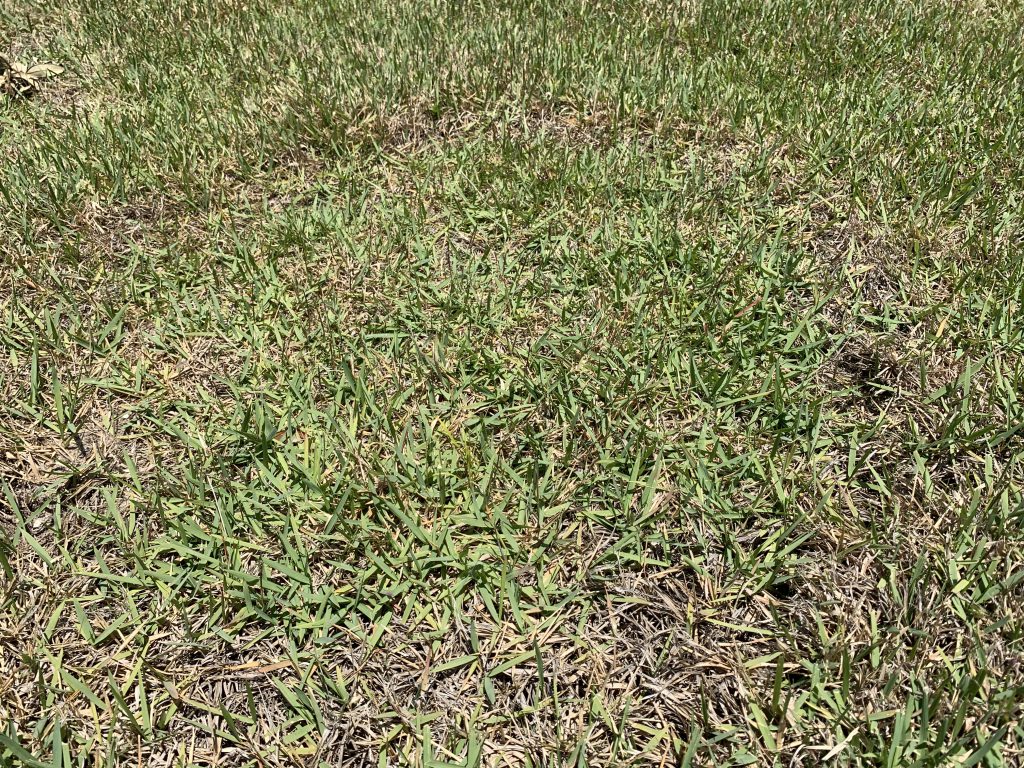
Rhizoctonia in a zoysiagrass lawn. Photo Credit: Matt Lollar, University of Florida/IFAS Extension – Santa Rosa County
This summer in Santa Rosa County, Rhizoctonia has been positively diagnosed in both St. Augustinegrass and zoysiagrass lawns and suspected in a number of centipedegrass lawns. The disease usually starts as small, yellow patches (about a foot in diameter) that turn reddish brown, brown, or straw colored as the leaves start to die. Patches often expand to several feet in diameter. It is common to see rings of yellow or brown turf with otherwise healthy turf in the center. The fungus infects portions of the blades closest to the soil, eventually killing the entire leaf. Grass blades can easily be pulled off their stems, but roots are not affected by the disease.
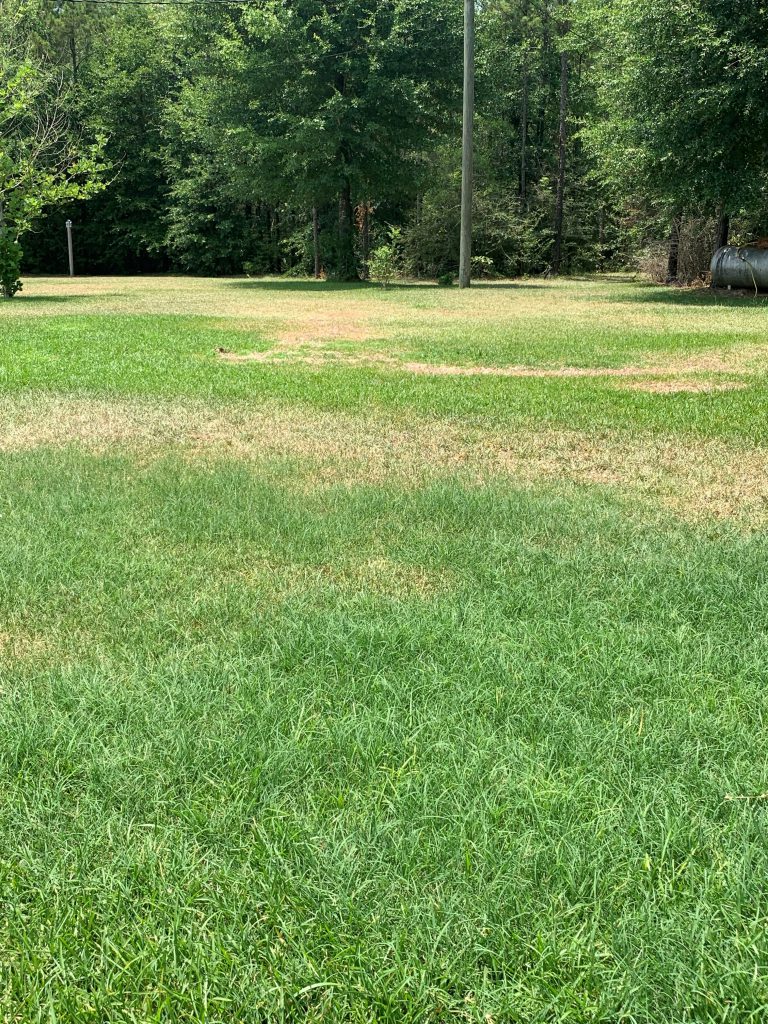
Rhizoctonia in a St. Augustinegrass lawn. Photo Credit: John Atkins, University of Florida/IFAS Extension – Santa Rosa County
Overwatering and excessive fertilization can both contribute to the development of Rhizoctonia disease. Improper timing of fertilizer application can also promote disease development. In the Florida Panhandle, turfgrass is actively growing from April to October. Slow-release fertilizers are recommended to allow for a more even distribution of nutrients over the course of multiple months. Recommended fertilizer rates are based on turfgrass species, geographical location, and fertilizer analysis. Please refer to the UF/IFAS Publication: “Urban Turf Fertilizer Rule for Home Lawn Fertilization” for rate recommendations.
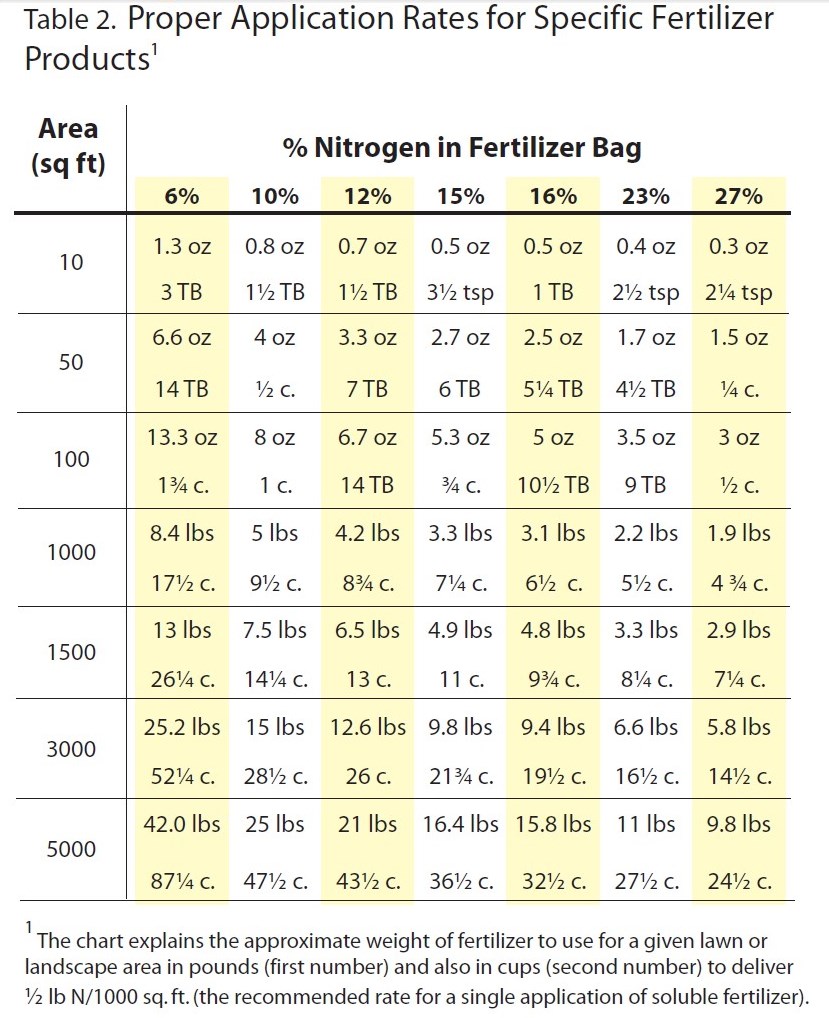
Chart excerpted from Florida-Friendly Landscaping publication.
If large patch or another Rhizoctonia disease is confirmed in your lawn, then chemical controls are necessary to keep the disease from spreading. Fungicide products containing the active ingredients azoxystrobin, chlorothalonil, fludioxonil, flutolanil, iprodione, mancozeb, metconazole, myclobutanil, polyoxin D, propiconazole, thiophanate-methyl, thiram, triadimefon, trifloxystrobin, or triticonazole are viable options for keeping the disease from spreading. For best results, follow the fungicide label for application instructions. It’s important to not only treat the affected areas, but also the healthy turf surrounding these areas in order to keep the diseased spots from growing in size.
Unfortunately, turf diseases are often not noticed until large patches of declining and dead turf are noticed. In these cases when large dead patches exist in the lawn, it is usually necessary to resod these areas. As with most problems that arise in the landscape, good cultural practices are the most proactive way to mitigate the chances with turfgrass diseases. The UF/IFAS Florida Friendly Website provides up-to-date solutions and recommendations for caring for Florida landscapes.
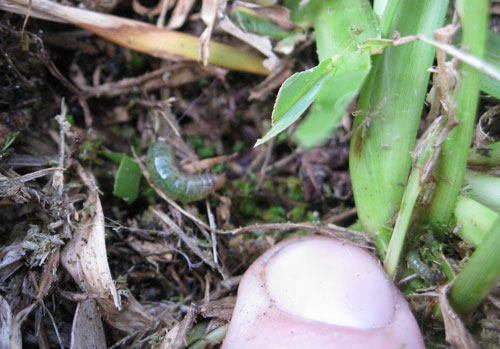
by Taylor Vandiver | Sep 9, 2014
What’s eating my lawn? Does your grass look ragged in areas, as if someone randomly used a weed-eater here and there? Are you noticing brown patches that have a closely clipped appearance compared to other areas of your lawn? Your turf may be playing host to Tropical Sod Webworm.
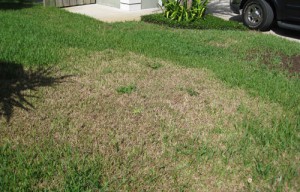
Sod webworm damage in a home lawn. Photo courtesy UF/IFAS.
Sod webworm damage is subtle at first. You have to look closely to notice larval feeding damage. However, an easy indication of their presence is the light tan/brown colored moths, which are the adult stage of the pest. You may see them fly up as you walk through your lawn or if you disturb a nearby bush. The moths do not cause any damage to the turf, but they are depositing eggs, which will result in their offspring, the caterpillars, who do all the chewing damage.
The larvae are gray-green and have spots on each segment. The mature larvae can be up to 1 inch in length. Larvae will curl up in the soil during the day and feed at night. So if you happen to notice caterpillars feeding during the day, it’s probably not sod webworm. You will notice chewed notches along the leaf blade, holes in the leaf and even leaf blade skeletonizing. The older the larvae are, the more they will eat. Damage may start out as a ragged appearance in your turf, which can be hard to diagnose. However, if left unchecked, sod webworm can cause considerable injury to your lawn.
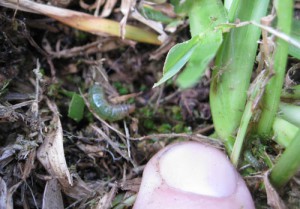
Sod webworm larvae. Photo courtesy UF/IFAS.
If you are uncertain of their presence you can always use a soap drench to flush out larvae. Mix 2 tablespoons of dish soap with 2 gallons of water and pour it over a damaged area (about 3 square ft.). The soap mixture will irritate the pest and bring them to the surface so you can easily identify them. If nothing appears in the area tested move to another damaged site and try again. Here is a link to a video that will give more information on identifying Tropical Sod Webworm.
Tropical Sod Webworm is considered a pest of all warm-season turfgrasses. However, St. Augustinegrass is most commonly affected. The best way to prevent a pest infestation is to use proper cultural maintenance practices for your lawn type. However, if the pest does appear, chemical control should be targeting the larvae stage of the pest. There are multiple products marketed to control lawn caterpillars. However, you may want to consider using B.t. (Bacillus thurengiensis), which is a bacterium that will only harm caterpillars and not bother beneficial insects that may be in your lawn. For more information you can contact your local extension office.












